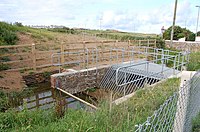Key:inlet
| Description |
|---|
| Point where a fluid enters a pipe or a machine. |
| Group: man made |
| Used on these elements |
| Documented values: 7 |
| Useful combination |
| See also |
| Status: approved |
| Tools for this tag |
|
Inlets refer to points where a fluid enters a pipe or a machine. Inlets are key features in fluids, particularly water, management infrastructure and have influence on how culverts or pipeline are operated.
Any inlet can be mapped, even if the pipe/machine it is related to is not (e.g. manhole covers or kerb openings). The most common waterways that have inlets mapped are tunnel=culvert, tunnel=flooded or man_made=pipeline. Use outlet=* for places where fluids go out a pipe or a machine.
They can be found in many places and can mark a limit between natural and artificial waterways. Some inlet features only allow liquids to pass through if a certain level is reached or if a certain nearby environmental or system condition is satisfied (such as overflow mode). Inlet features can also provide secondary function of filtering medium to large sized debris from the flow.
Mapping them is useful to know how solid matters (including waste) could be retained in ditches, rivers, storm drains or where water is taken out of natural waterways. It's currently possible to look for artificial intakes with topological limits between different linear features. Mappers will often find screens, strainers or other solid retaining features there without available tagging to map them.
This documentation only focuses on liquids. It would be possible to extend it to gases if required.
No substance on inlets
inlet=* is intended for the largest variety of fluids going through. OSM mappers are kindly invited to only tag inlets according to their own properties. Knowledge of the fluid coming in is a matter for the pipe or tunnel network the inlet is a member of. As a consequence, it is not recommended nor desired to reproduce values of substance=* or usage=* related to pipe on the inlet's ![]() node. Such data could easily be reproduced with pre-processing.
node. Such data could easily be reproduced with pre-processing.
However, as there are situations where an inlet can be the only visible part of a larger underground infrastructure network that we are unable to map in OSM for various reasons, it would be possible to add substance=* on the inlet when mapped on a stand-alone ![]() node without being a member of a tunnel or a pipeline
node without being a member of a tunnel or a pipeline ![]() way feature.
way feature.
How to map
Put a ![]() node at the junction between a
node at the junction between a ![]() way representing a culvert or pipeline and the open air or another uncovered waterway, then use inlet=* to describe this inlet.
way representing a culvert or pipeline and the open air or another uncovered waterway, then use inlet=* to describe this inlet.
| Tag | Description | Presence |
|---|---|---|
| inlet=* | It's an inlet (see values below). | Mandatory |
| flow_rate=* | Nominal flow rate for which the inlet is designed | Optional |
| substance=* | Substance flowing through the inlet | Only where the parent duct or pipe is not mapped |
| handle=* | Manual means of actuating the inlet | Optional |
| actuator=* | Mechanical means of actuating the inlet | Optional |
| width=* | Width of the inlet, if applicable | Optional |
| height=* | Height of the inlet, if applicable | Optional |
| diameter=* | Diameter of the inlet, if applicable | Optional |
| colour=* | Colour of any grate/cover/lid covering the inlet (preferred over surface:colour=*, material:colour=*, etc.) | Optional |
| material=* | Simple material of any grate/cover/lid covering the inlet (e.g. material=metal) | Optional |
| surface=* | The surface of any grate/cover/lid covering the inlet, when that grate/cover/lid is consistent with the surrounding surface (e.g. if the grate/cover/lid is made of paving stones, use material=paving_stones). The additional details that follow that tagging scheme can also be used (e.g. paving_stones:pattern=*), however colour=* should be used instead of surface:colour=* (see above). | Optional |
When mapping inlet=grate or inlet=kerb_grate, the tags man_made=manhole and manhole=drain must also be used when these inlets are also manhole cover drains.
No consensus has been made on how to tag covered gutters that are mapped as a ![]() way, however inlet=* should not be used as this key is limited to only be used on
way, however inlet=* should not be used as this key is limited to only be used on ![]() nodes. See the Key:inlet talk page for a discussion on how this feature should be tagged.
nodes. See the Key:inlet talk page for a discussion on how this feature should be tagged.
